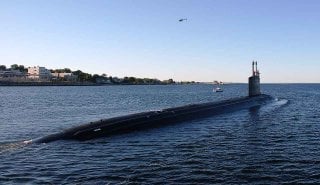The Next Three Virginia-Class Submarines Now Have Names
Meet the USS Potomac (SSN-814), future USS Norfolk (SSN-815), and future USS Brooklyn (SSN-816).
The United States Navy's Virginia-class fast attack submarines program is now running nearly three years behind schedule, while it has been projected to cost more than $17 billion over the planned budget through the decade's end. However, the boats remain critical to the U.S. strategy to confront China in the Indo-Pacific.
It has become an example of a military program that could be described as "too big to fail," and the service has no choice but to continue forward and face the challenges. Even as the progress may not be where Navy officials would like to see it, this week outgoing Secretary of the Navy Carlos Del Toro announced the names for three of the future boats of the class.
These will include the future USS Potomac (SSN-814), future USS Norfolk (SSN-815), and future USS Brooklyn (SSN-816).
"Today's submarine force is the most capable force in the world and in the history of the U.S. Navy," said Secretary Del Toro in a statement on Monday. "It is my honor and privilege to announce the names of the future submarines which will protect us from deep below the ocean's waves."
This follows the naming of the USS Long Island (SSN-809), USS San Francisco (SSN-810), USS Miami (SSN-811), USS Baltimore (SSN-812), and USS Atlanta (SSN-813).
USS Potomac
SSN-814 will be the sixth vessel named for the major river that flows through three states in the Mid-Atlantic region of the U.S. from the Potomac Highlands of West Virginia, and past the nation's capital of Washington, D.C. before emptying into Chesapeake Bay.
The first USS Potomac was a "fifth rage frigate" that was built at the Washington Navy Yard between August 1819 and March 1822, but not commissioned until 1831. The warship saw service in both the Mexican-American War and the U.S. Civil War, before being decommissioned in 1877. The second vessel named for the river was a whaler purchased by the U.S. Navy and used as the "Stone Fleet," part of the Blockade Strategy Board's plan to sink old vessels to block Confederate harbors.
The third USS Potomac (AT-50) was a fleet tug built in 1897 and used during the Spanish-American War, armed with "six-pounder guns." According to the Navy, the vessel later served as "a fleet and submarine tender, as well as supporting Marine Corps operations in the West Indies."
AG-25 was the fourth USS Potomac, formerly the United States Coast Guard Cutter (USCGC) Electra. The vessel served as the private presidential yacht for President Franklin D. Roosevelt from 1936 until 1945. The 165-foot-long vessel, which has been preserved as a museum, was used by FDR during his getaways from the White House and to host foreign dignitaries.
Two different U.S. Navy oilers were named for the river and they even shared a bit more. The first was the Maumee-class oiler USNS Potomac (TA-AO-150), which was wrecked in 1961 after suffering a devastating fire. However, while the forward section "was declared a total loss," the salvaged stern section was reconstructed as the SS Shenandoah but later renamed USNS Potomac (T-AO-181) after being "accepted back into the Navy service as part of Military Sealift Command." The oiler saw operations during the Persian Gulf War and later provided humanitarian relief following Hurricane Katrina in 2005.
USS Norfolk
Five vessels have been named for the Virginia coastal city that is now home to Naval Station Norfolk but only three were completed. These included a brigantine (brig) built in Norfolk during the Quasi-War with France; followed by the destroyer leader DL-1the only ship of her class, the vessel service from 1953 until 1970.
The two unfinished vessels included CL-118 was to be the final Fargo-class light cruiser (a modified version of the Cleveland-class) but construction was halted in August 1945 and the unfinished vessel was scrapped. During construction CL-118's name was changed to USS Chattanooga as Norfolk was given to the planned CA-137, an Oregon City-class heavy cruiser. The vessel was also canceled in August 1945 and scrapped.
The final former USS Norfolk (SSN-714) was a Los Angeles-class nuclear-powered fast-attack submarine that entered service in 1983. She was decommissioned in 2014. The future SSN-815 will fill a similar role.
USS Brooklyn
SSN-816 will be the fourth vessel named for the Big Apple's borough of Brooklyn. The first was a wooden screw sloop launched in 1858. The vessel was part of the U.S. Navy's West Gulf Blockading force in the Gulf of Mexico, and she took part in campaigns at New Orleans, Vicksburg, Pensacola, and Mobile Bay.
The second USS Brooklyn (CA-3) was a first-rate armored cruiser, launched in 1895. During her first deployment, she carried representatives from the United States to the Diamond Jubilee for Queen Victoria and was later among the U.S. Navy warships that took part during the July 3, 1898, Battle of Santiago in which the U.S. destroyed the Spanish Fleet in the Spanish-American War.
The most recent previous USS Brooklyn (CL-40) was the lead vessel of a class of light cruisers. Launched in 1936, the warship conducted anti-submarine warfare (ASW) operations in the Caribbean during the Second World, and later supported the Allied landings in North Africa, Sicily, and Anzio, before taking part in the Operation Dragoon, the invasion of southern France in August 1944. The cruiser earned four battle stars for her role in World War II.
In 1951, as part of the Mutual Defense Assistance Program, CL-40 was transferred to the Chilean Navy and renamed O'Higgins (CL-02).
Peter Suciu is a Michigan-based writer. He has contributed to more than four dozen magazines, newspapers, and websites with over 3,200 published pieces over a twenty-year career in journalism. He regularly writes about military hardware, firearms history, cybersecurity, politics, and international affairs. Peter is also a Contributing Writer for Forbes and Clearance Jobs. You can follow him on Twitter: @PeterSuciu. You can email the author: [email protected].
Image: Wikimedia Commons.

